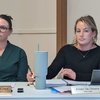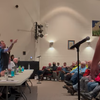Strong showing at Knox broadband focus group wins praise from CanCode organizers
KNOX — As she walked about 30 Knox residents through a survey on their internet connectivity experience, CanCode founder and Chief Executive Officer Annmarie Lanesey made a number of remarks about the strong showing, saying that it bodes well for the town as it attempts to bridge the connectivity gap.
“This is an astounding turnout,” Lanesey said, after commenting that it was “probably the biggest turnout” she had seen at such an event.
“We will continue to advocate for continued resourcing for this town because you’re already organized,” she said. “And that’s a huge, huge advantage over many other places … It will be a much easier project to get this community connected than it would be in some other places where there’s not already organization.”
CanCode is a not-for-profit organization dedicated to expanding technology skills that, as a member of the Capital Region Digital Equity Coalition, has been tasked with collecting data on behalf of New York state, which is currently trying to figure out how to direct funding through its ConnectALL program so that communities have access to high-speed internet.
Along with CanCode’s deputy director, Rachel Sheridan, Lanesey was in Knox to gather stories and information about the residents here, who, like those of many other rural communities in the Capital District, have complained about not having quality internet connections.
This effort, Lanesey said, was the “first time in the history of the state of New York” that information was being collected at such a granular level.
“They’ve done surveying before,” she said, “but they are really trying to get a baseline of data to really understand the issues.”
This is important because current maps are not sufficiently accurate when it comes to figuring out which households have the ability to subscribe to a wired internet service, as one attendee demonstrated when he pulled up a map showing his home as “served” when in fact it’s not.
And whatever surveys may have gone out prior to this did not penetrate very deeply into the group of residents at the Knox meeting who were motivated enough by the issue to show up in person, with only a handful raising their hands when asked if they had filled out a broadband survey before.
But practically every single attendee raised a hand when asked if they relied on the internet for healthcare, socializing, public benefits, and civic engagement.
Half said they had used the internet for learning, and only slightly less had used it for healthcare.
One woman said that she’d like to use the internet for home security like the Ring doorbell camera that lets people see who’s outside their home, so long as they have a stable internet connection.
“My observation is that the expectation of a good internet connection has creeped up on us,” said Knox Supervisor Russ Pokorny, who is also a member of the town’s broadband committee, which co-organized the event. “Even if you went back 10, 12 years … it was like, ‘Oh, that’s a nice thing to have.’”
Now, he said, it’s critical.
Most of the attendees said that they rely on wireless internet connections, such as through Verizon, which sells hotspot devices and subscription packages, but, like many other wireless companies, imposes data caps that can be reached quickly, especially when doing data-intensive things like streaming video.
Teleconferencing has become increasingly popular since the COVID-19 pandemic forced people to handle nearly all their business from home, including doctor’s visits, which often require a certain degree of visualization. And, although social distancing is no longer a widespread factor, many — especially in remote areas like the Hilltowns — choose to continue seeing doctors remotely.
But, one man said of telemed visits, “If they want to look at our mole, they can’t, because the signal drops out.”
Alternative options like satellite are either faulty or prohibitively expensive, attendees noted, with broadband committee member Tom Wolfe noting that one satellite service he tried was “only a step up from dial-up.”
Broadband isn’t an option for many because the infrastructure isn’t in place yet, and the sparse population makes companies unlikely to pay for installation. One woman who inquired about fronting the cost for the extension of wires to her house was told it would be $9,000; another woman was told it would be 10 times that.
So, when some attendees need a solid internet connection, whether it’s to handle a large software update or take a class, they trek to a library — Knox does not have a library in town — or to the town hall or wherever else they can pick up a good wi-fi connection.
One Berne-Knox-Westerlo teacher in attendance said that he has to wait until he’s at school to use the internet, which gets in the way of interacting with students, who now are free to send emails about homework at any hour (assuming they have internet, which many don’t, as The Enterprise has previously reported).
In addition to struggling to connect consistently, many in the group also acknowledged having low-to-average comfort navigating online once a connection is established, which is considered a barrier to connectivity.
Because the internet — its interfaces, cultures, and the schemes that exist throughout — develops faster than people can get a handle on it, using even a once-familiar website can be tricky, some remarked.
Several said they’ve had their credit-card information stolen, often more than once. Part of the problem, one man said, is that, however safe an individual is, the corporations they divulge their information to can often be vulnerable to hackers.
“I’ve worked in computer science, I’ve worked in software engineering, all these things, and I don’t rate myself high [on comfort],” Lanesey said.
According to the National Digital Inclusion Alliance, New York State is ranked 38th in the country when it comes to “digital opportunity” measurements, with around a third of unemployed residents lacking the digital skills necessary to apply to the 77.3 percent of jobs available that require those skills.
These stats are compounded by the fact that the state doesn’t have a robust system in place for addressing the issue.
While bad news for those who need public support in this area, Lanesey pointed out that the low score will put New York higher on the priority list when the federal government distributes $61 billion in digital equity to the states based on need.
“The moral of the story is … get everyone to fill out the survey,” she said, having already noted that the quality of information-gathering will also likely be a factor in how much each state receives.
The survey can be accessed at the following link: https://bit.ly/connectall-survey.
The hope is that more communities will be able to end up like Westerlo, whose ability to self-organize netted it $1.7 million in public money for broadband expansion.
Knox broadband committee member Beth van Bladel said the town is working on creating as accurate a map as possible, because it’s likely to be an important aspect when applying for funding. Wolfe mentioned that the committee could make use of geographic information systems (GIS) experts if any were to volunteer their time.
The committee is also currently working with Spectrum to get a sense of where broadband infrastructure is needed and how much it would cost to put it into place, van Bladel said.
“What we want to do is a public-private partnership,” she said. “We’re going to get our data together and make our case, so, Spectrum, if you can help us get the data clean, then we can direct those funds from these programs to you to get us connected. It’s a win-win.”



